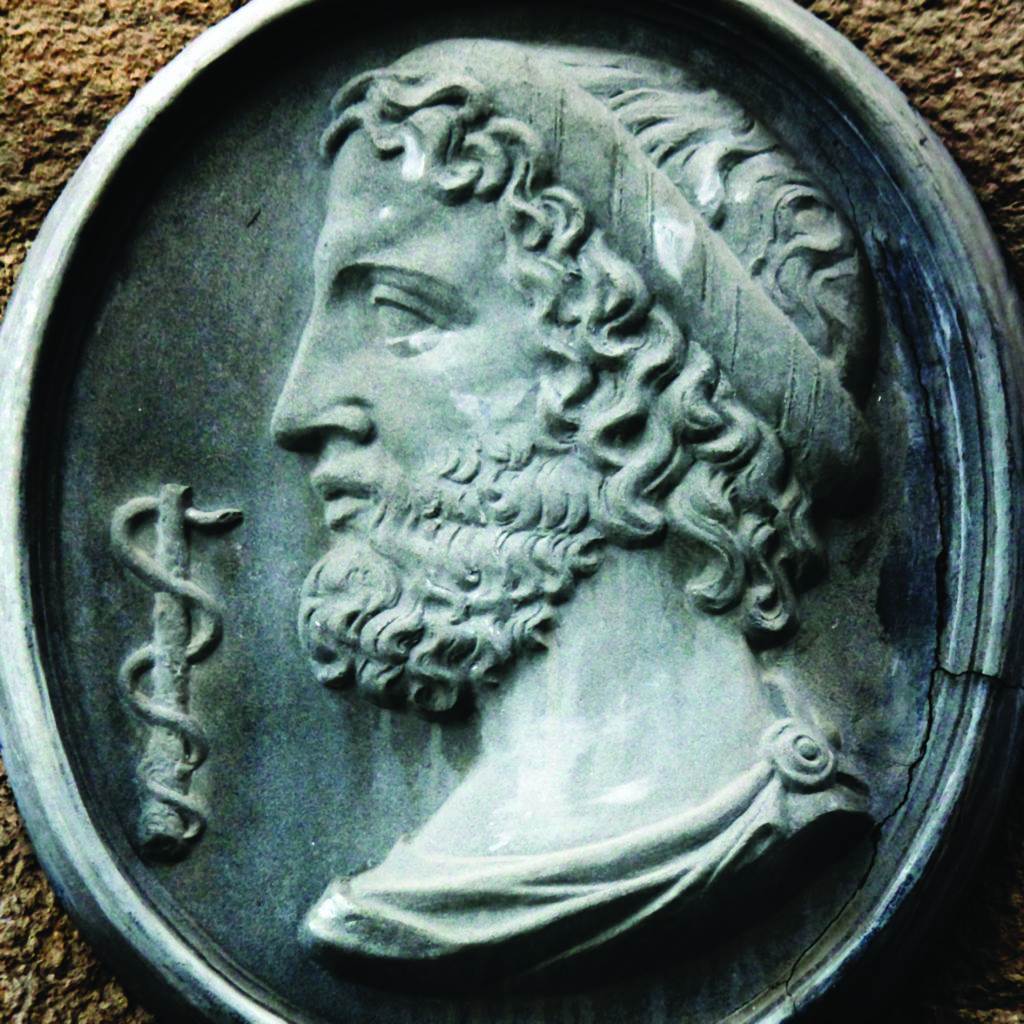Healing from the
Era of Asclepia
BY JENNIFER DUMPERT
The practice of dream incubation entails engaging the dreaming mind to help address personal or intellectual questions, to encourage healing, or to enliven intuition and boost creativity. The origins of modern medicine include dream incubation. In ancient Greece, pilgrims seeking cures for various ailments flocked to temples dedicated to the god Asclepius. Called Asclepeia, these temples served as both shrines and hospitals. Snakes, sacred to Asclepius, were used in healing rituals and also crawled freely across floors where the sick and injured slept. Thus the symbol of healthcare and medicine—a snake wrapped around a staff, called the Rod of Asclepius.
Priests of Asclepius also served as doctors. The original Hippocratic oath—the central tenet of Western medicine—began with an invocation to Asclepius. Hippocrates may have begun his career at an Asclepion. Priests employed many methods to treat physical and spiritual ailments, including herbs, nutrition, and even simple surgeries. They also interpreted dreams that resulted from dream incubation.
Pilgrims seeking healing arrived at a temple and went through a purification process. They then used relaxation and visualization techniques to focus on their problem. Finally, these supplicants went to sleep seeking wisdom that would be delivered in the dream. In the light of day the physician priests performed physical examinations of patients and also reviewed their dreams, seeking insight into possible treatments. Remedies often involved natural medications, physical exercise, and semidevotional acts.
Modern forms of dream incubation are used by dreamers from all walks of life to seek healing, solve intellectual and personal problems, and generally get in touch with the wisdom of the dreaming mind. The form of dream incubation I teach integrates REM, hypnagogia, and hypnopompia. We pass through five phases of sleep every night, identified by varying EEG signatures. Dreams occur in four of them.
The first, hypnagogia, occurs right at the edge of sleep. As you drift off, you pass through this kaleidoscopic, free-associative dream state. Your mind can stay conscious as you begin to dream. With a bit of practice you can train yourself to linger here and to vary the degree of waking consciousness you bring into hypnagogic dreams. Artists, inventors, philosophers, and thinkers have long harnessed the power of hypnagogia to gain insight, boost creativity, and promote healing. REM (rapid eye movement) dreams happen throughout the night. However, once you’ve been asleep for four hours, periods of REM start to get longer. The more you sleep the more REM you experience.

Hypnopompia, the twin of hypnagogia, happens as you wake. Floating through this deeply relaxed state of being, your mind meanders back and forth across the border of waking thought and drifting dream. Here you can gently access parts of your experience that your waking mind has a harder time encountering.
To practice dream incubation, familiarize yourself with your most common sleep positions. To determine that, pay attention to how you’re positioned most frequently when you wake up or fall asleep. As anyone knows who plays sports or a musical instrument, or has an embodied practice like yoga or tai chi, the body has memory. Once you find a flow, mind follows movement. Trying to remember dreams can work the same way. Whenever you try to recall a previous night’s dream, get into one of your regular sleep postures and relax into it. Memory may come.
Choose a time when you can linger in bed in the morning. Turn off the alarm clock and turn on Do Not Disturb on your phone. Shut the kids and cats out of your room. Now you’re ready to try dream incubation!
Go to bed. Lie in one of your normal sleep positions and form a question, or just get a clear mental image of the issue you want to address—anything from a broken foot to a broken heart to broken code.
Try to maintain awareness of your question through hypnagogia. Breathe slowly and deeply. Relax, but try to keep your question in your head right up until the moment you fall asleep. Like Salvador Dali, Thomas Edison, August Kekulé (who discovered the benzene ring), or Marcel Proust, you may find that hypnagogic dreams provide powerful insight.
Next, literally sleep on it. That phrase exists for a reason. Let your unconscious mind meditate on whatever you’re cogitating. Your dreaming psyche approaches problems at a very deep level.
In the morning, wake as slowly as you can. Linger in the gentle, open, sweet space of hypnopompia. One part of your experience will involve thought. As you surface into consciousness, you’ll start to have ideas and memories. But the other part of your mind will loiter in dream. Slowly shift into your different sleep positions and drift off again. Your body memory will find the associations with the intention you set in hypnagogia as well as dream revelations from REM.
Keep something by your bed to capture whatever comes into your head. I keep a voice-activated recorder by my pillow. You can purchase devices or smartphone apps that start recording once you start talking. You can also keep a notebook to write down thoughts or a sketchpad to draw images.
As with all practices, the more you do it, the better you’ll get at it. The effectiveness of dream incubation rests on the belief that your psyche knows what serves you best. Try this ancient practice. Dream and heal thyself!
Jennifer Dumpert writes and lectures about liminal dreaming and is founder of the Oneironauticum. She tweets a dream a day @OneiroFer. UrbanDreamscape.com